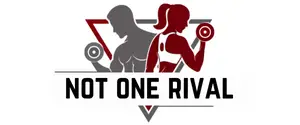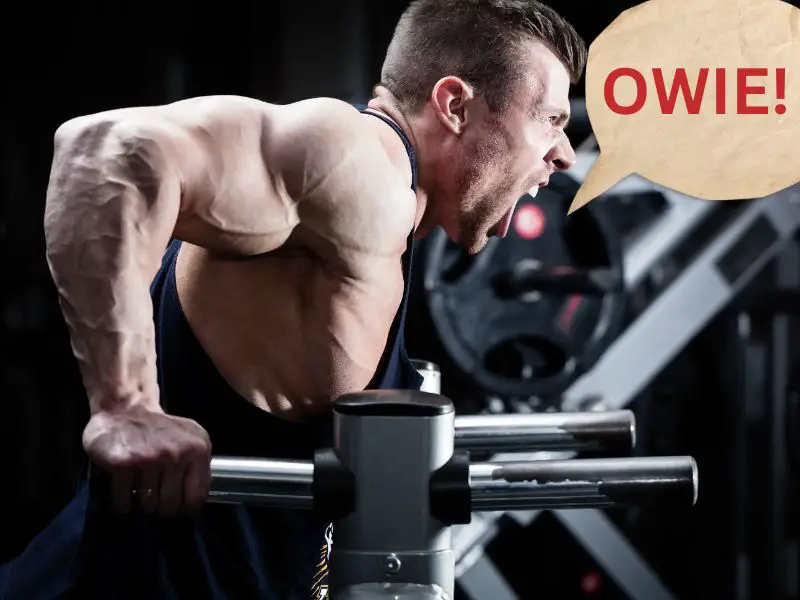Dips are an excellent exercise to build your chest and triceps. That said, a common problem many people run into with them is shoulder pain. Particularly, most people will notice pain in the front delts that are very active during a dip. And in rare cases, some may also get pain toward the back of the shoulder.
I had these issues myself a couple of years ago. Fortunately, after some tedious research, I found a solution to my problem. With this guide, I will outline everything I learned on how to avoid pain from dips. That way, you can avoid the hours of research I had to do to find the right solution. Keep reading for all the details.
Key Takeaways
- Poor form is a common cause of shoulder pain on dips.
- Many mobility exercises can be used to help.
- It’s important to add weight slowly with dips to avoid overexertion on the shoulder muscles.
Understanding Shoulder Pain from Dips
The first thing you’re probably wondering is, “what’s causing the shoulder pain I’m experiencing on dips?” Here are the possible reasons you may be experiencing pain.
- Poor form: Like many other exercises, poor form on dips can often be the culprit. This is especially true since dips activate many stabilizing muscles while also putting more weight toward the front of the shoulders. If you don’t brace correctly or go too low, it can cause several problems.
- Lack of mobility: Many lifters can struggle with mobility issues when they lift heavy and want to get in and out of the gym quickly, often neglecting proper warm-ups or post-workout stretching. Over time, low mobility can cause more stress and tension on the shoulder joint during dips. It can also lead to the use of poor form to compensate.
- Going too heavy too quickly: We all want to lift heavy to stack on more muscle mass, but you need to be careful adding weight to dips. For instance, lifters who try to add a 45-pound plate the first time they attempt weighted dips may run into pain and issues with the form if they aren’t prepared for it. So take it slow and work your way up.
Now that we have the key issues in mind let’s take a look at potential solutions.
How To Avoid Pain During Dips
Here are 4 key tips to avoid pain during dips based on the common causes.
1. Optimize Your Form
It sounds clichè because you always hear this advice of “use good form” in the fitness community. But it’s true and must be reinforced.
I had been doing bodyweight dips for years without issue before experiencing pain myself. But upon adding weight to them, I started having issues. It was because poor form caught up to me with the increased weight and intensity of the exercise.
The solution was that I wasn’t retracting my scapula during the exercise to protect the shoulders. It’s the same advice you may have heard when performing a bench press. You need to tuck your shoulder blades down and back. Many studies have found that not doing so on “push” exercises like bench presses, dips, etc., will cause muscular imbalances and pain.
To retract the scapula correctly, try shrugging your shoulders up, then (while in that shrug position) roll your shoulder blades back, and finally tuck the shoulders back down. You should feel the muscles active in your upper back and traps to maintain that position. That’s the retracted position you want to be in during dips to ensure shoulder health.
On top of that, other tips on form are:
- Use a slow and controlled motion.
- Avoid going too low. Your upper and lower arm should form a 90-degree angle while you’re at the bottom of the dip.
- Avoid holding your body too upright. While maintaining scapular retraction, you should lean your torso forward a bit to ensure your chest is getting activated. It takes stress off your shoulders.
If you’re following these tips, your form should not cause any further issues. You may sacrifice some weight and reps at first while perfecting your form. But you’ll thank yourself later when you can finally perform dips pain-free.
2. How To Improve Chest Mobility
If your chest isn’t properly warmed up or is tight, it can cause you to put extra pressure on your shoulders during dips. Here are some exercises that can help.
Bent-Arm Wall Stretch
This is a great chest stretch you can do pretty much anywhere you have access to a wall. You simply bend one arm at a 90-degree angle and place that forearm and palm flat against a wall. Then rotate your torso in the opposite direction until you feel a light stretch in the pec on that side. Hold this for 30 to 60 seconds, and feel free to repeat 2 or 3 times until you feel loose.
Foam Roller or Lacrosse Ball
Another great way to mobilize the pecs is using a foam roller or lacrosse ball. You want to lay with your stomach facing the ground. Then put your choice of a foam roller or lacrosse ball under your chest. Put light pressure on it while rotating to different angles to loosen up the chest.
3. How to Improve Shoulder Mobility
Tight shoulders can also be a cause of increased tension during dips. Here are some exercises that can help.
Shoulder Capsule Stretch
The shoulder capsule stretch is a great one to get a nice shoulder stretch anywhere without putting too much stress or exertion into your mobility routine. You simply bring one arm horizontally across your chest. Then, use the other hand to apply light pressure on the outside until you feel a stretch in the side and front of your shoulder.
Banded Latissimus Dorsi Stretch
This one targets the lats and back a bit more, but you still get a nice stretch through the side of your shoulder too. For this one, you’d attach a light resistance band to a power rack, pole, or other sturdy object at just above shoulder height. Then you grab it with one arm, keep that arm straight, and bend down (shifting the weight back into your hips) until you feel a nice stretch.
Dead Hangs
Another exercise that can help loosen up the shoulders and upper back to get ready for dips is a dead hang. As the name implies, it involves hanging from a pull-up bar for a duration of time. When performing it, be sure to keep your shoulders back and retracted, maintain a neutral spine, and use a pronated grip (palms facing away from you) for an easier grip.
4. How To Add Appropriate Resistance to Dips
Last but not least, you want to make sure you’re not going too heavy on dips. Ideally, when you start getting into weighted variations of dips, add the weight slowly.
Try to start with a weight you can comfortably perform a few sets of 10 reps with. Once you can do around 3 or 4 sets of 15 reps with that same weight, try bumping it up 5 to 10 pounds.
If the weight ever feels too heavy, or you start feeling your form breaking down, drop it back down to where you feel comfortable.
Alternative Exercises to Dips
Dips aren’t always a great entry-level exercise for new lifters. It depends on where you’re at in your fitness journey and how in shape you are when starting. Personally, it took me about a year to build up the strength required to perform exercises like dips and pull-ups.
Others simply may not like the exercise and want to do something else that targets the chest and triceps.
Fortunately, whatever the reason you may want alternatives, there are plenty.
Barbell or Dumbbell Bench Press
For an exercise that targets the chest a bit more, going with a traditional barbell or dumbbell bench press will be great. Plus, you can typically load up a barbell with weights much easier than trying to attach a few 45-pound plates to a dip belt and get in the proper position.
I often find it more convenient to do heavier work on the bench press and save dips as an accessory exercise using higher reps.
Push-Ups
If you want an alternative bodyweight exercise for the chest and triceps, you can’t go wrong with push-ups. Plus, if you’re looking for an exercise that will have a direct carryover to your bench press, I’ve found weighted push-ups to be excellent for that. Push-ups are also easier on the shoulders and easier to perform for most people.
Skullcrushers
Those looking to directly target the triceps may find skullcrushers to be a great alternative. They require much less stability than a dip, and you can still load them up pretty heavy when you get the form down.
Dumbbell Overhead Tricep Extension
Another simple tricep builder, this one can be done anywhere you have access to a dumbbell. It again requires much less stability than a dip, while targeting your tricep muscles directly.
Conclusion
That wraps things up for this one. You should have a better idea of what may be causing your shoulder pain on dips and how it can be avoided.
Of note, if you’re experiencing severe shoulder pain on dips or after working out, you shouldn’t try to push through it. Always check with a doctor to make sure you don’t do more harm than good.
Other than that, try these options out and see what works best. You can tackle shoulder pain and get back on track with your fitness goals!
FAQ
Can Dips Damage Your Rotator Cuff?
If you do dips with improper form or go too heavy for a long amount of time, it could cause rotator cuff problems, just like many other exercises. However, when done with good form and proper precautions, dips are a very safe exercise for most lifters.
Are Dips Good for Shoulders?
You may have heard some lifters say dips work wonders for their shoulders. And there is some truth to that. Dips do help build the musculature around the shoulders. When performed with good technique, they may even feel more natural than a stiff barbell bench press to build your chest and triceps.
Can I Do Dips Every Day?
You probably shouldn’t do dips every day. For most lifters, it’s best practice to let your chest, shoulders, and triceps recover for 2 or 3 days after a hard training session before doing dips again.
How Deep Should You Go On Dips?
Most lifters should aim to have their upper and lower arm form a 90-degree angle while at the bottom of the dip. It ensures you maintain tension on your chest muscles without having form break down.
Do Bench Dips Damage Shoulders?
Just like parallel bar dips, bench dips can damage the shoulders when done with improper form. Typically, when you’re leaning too far forward and putting too much stress on the shoulders, you may feel shoulder pain while performing bench dips. Be sure to keep your shoulders tucked back and down for the best results.
CITATIONS AND SOURCES
Contemori, S., rhythm, A. to scapulohumeral, Biscarini, A., Finley, M. A., Hermens, H. J., Johnson, G. R., Picco, B. R., Thigpen, C. A., Wu, G., Borstad, J. D., Contemori, S., & Cools, A. M. (2019, January 16). Effects of scapular retraction/protraction position and scapular elevation on shoulder girdle muscle activity during glenohumeral abduction. Human Movement Science. https://www.sciencedirect.com/science/article/abs/pii/S0167945718304743?via%3Dihub
- Best Pull Up Bar Diameter For You: A Comprehensive Guide - September 4, 2023
- Grip Talk: What is Barbell Knurling & Why It Matters? - September 4, 2023
- Say Goodbye to Shoulder Pain: How to Avoid Pain from Dips - September 4, 2023

